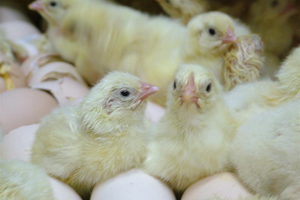Hatch time influences live performance of broiler chicks

Hatching eggs from broiler breeder flocks (Ross 344 X 308SF) at 59 and 55 weeks of age were used in two experiments.
Eggs were stored in a cooler for 1-3 days prior to setting in Petersime incubators under standard single-stage conditions.
Early hatch time was 472-480 h or 471-477 h, middle hatch time was 488-492 or 480-486 h, and late hatch time was 496-510 h or 494-510 h, respectively, in experiments 1 or 2.
Chicks were deemed to be hatched when they exhibited healed navels and dryness about the head and neck. At 510 hours of incubation, hatched chicks were removed from the trays, feather sexed, counted, identified with neck tags, weighed, and placed in floor pens on new wood litter shavings.
Chicks were necropsied and yolk sac weight determined at placement in pens and 24 hours later in experiment 1 and immediately at each hatch time (477 h, 486 h, and 510 h) and also at placement in experiment 2. For each hatch time, chicks were assigned to 8 pens of 10 male and 10 female chicks each or 9 pens of 9 male and 9 female chicks each for a total of 480 or 486 chicks in experiments 1 and 2, respectively. Body weight and feed consumption were determined at 1, 7, 28, and 35 days of age or 7, 14, 21, and 35 days of age in experiments 1 and 2, respectively. Mortality was noted daily.
Data from the 3 (hatch time) x 2 (sex) completely randomised design were subjected to analysis of variance. Percentage yolk was greater in late hatch compared to early and middle hatch chicks at placement and at 1 days in experiment 1. Percentage yolk was similar in all groups in experiment 2 at hatch time but early hatch chicks exhibited less percentage yolk at placement.
Chick body weight was greater at placement in late hatch chicks compared to early hatch chicks in both experiments but this was no longer apparent by 7 days. Body weight was greater in the middle hatch compared to late hatch chicks with early hatch chicks intermediate at 7 and 35 days in experiment 1.
Although early and middle hatch chicks exhibited greater body weight loss between hatch and placement and lower body weight at placement compared to late hatch chicks, early hatch chicks had significantly larger body weight than late hatch chicks with middle hatch chicks intermediate at 35 days in experiment 2. Late hatch chicks consumed less feed and exhibited lower relative growth rate to 7 days and exhibited greater cumulative mortality in both experiments. Late hatch chicks had greater percentage yolk sac and body weight at 510 h of incubation, which was followed by reduced feed consumption to 7 days. Mortality and body weight gain was also poorer in late chicks relative to early and middle hatch chicks.
Source: John Brake, North Carolina State University, Raleigh, NC, USA and Serdar Ozlu and Okan Elibol, University of Ankara, Ankara, Turkey
Proceedings of the 2014 International Poultry Scientific Forum, Atlanta, GA, USA












